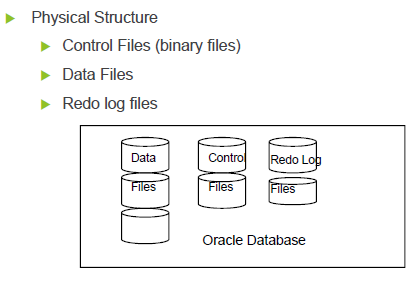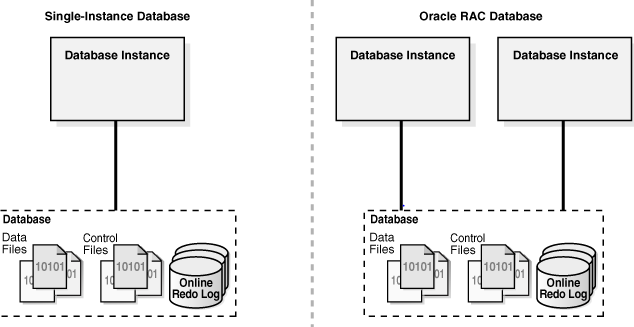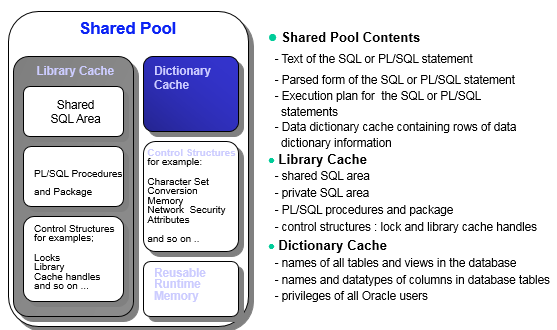Below are some of the Oracle DBA Basic Interview Questions Part A for both fresher and Experienced DBA.
Q 1. What is oracle database ?
Answer: Oracle Database is a relational database management system (RDBMS) which is used to store and retrieve the large amounts of data. Oracle Database had physical and logical structures. Logical structures and physical structures are separated from each other.


Q 2. What is the difference between Oracle database and Oracle instance ?
Answer:Oracle database is the collection of datafiles,redologs and control files while Oracle instance is the SGA ,processes in the Memory.
We can have 1 or more instance serving a oracle database . In Oracle RAC, we have one set of datafiles,control file and redo logs while instance on one ore more boxes accesses the same database.

Q 3. What is a Tablespace ?
Answer: Oracle use Tablespace for logical data Storage. Physically, data will get stored in Datafiles. Datafiles will be connected to tablespace. A tablespace can have multiple datafiles. A tablespace can have objects from different schema’s and a schema can have multiple tablespace. Database creates “SYSTEM tablespace” by default during database creation. It contains read only data dictionary tables which contains the information about the database.
Q 4. What are Datafiles ?
Answer:The datafiles contain all the database data. The data of logical database structures, such as tables and indexes, is physically stored in the datafiles allocated for a database.
Q 5. what is Control Files ?
Answer:Every Oracle database has a control file. A control file contains entries that specify the physical structure of the database such as Database name and the Names and locations of datafiles and redo log files.
Q 6. What is Redo Log Files ?
Answer The primary function of the redo log is to record all changes made to data. If a failure prevents modified data from being permanently written to the datafiles, then the changes can be obtained from the redo log, so work is never lost.
Q 7. What is Archive Log Files ?
Answer:Oracle automatically archives log files when the database is in ARCHIVELOG mode. This prevents oracle from overwriting the redo log files before they have been safely archived to another location.
Q 8. What is Parameter Files (initSID.ora) ?
Answer:Parameter files contain a list of configuration parameters for that instance and database.
Q 9. What is schema ?
Answer:A user account and its associated data including tables, views, indexes, clusters, sequences, procedures, functions, triggers,packages and database links is known as Oracle schema. System, SCOTT etc are default schema’s. We can create a new Schema/User. But we can’t drop default database schema’s.
Q 10. What is data blocks ?
Answer:Data Blocks are the base unit of logical database space. Each data block represents a specific number of bytes of database space on a disk.The data blocks can be 4 K,8 K size depending on the requirement.
Q 11. What is an Extent ?
Answer:Extent is a collection of Continuous data blocks, which is used for storing a specific type of information.
Q 12. What is a Segment ?
Answer:A segment is a collection of extents which is used for storing a specific data structure and resides in the same tablespace.

Q 13. What is Rollback Segment ?
Answer:Database contain one or more Rollback Segments to roll back transactions and data recovery.
Q 14. What are the different type of Segments ?
Answer: Data Segment(for storing User Data), Index Segment (for storing index), Rollback Segment and Temporary Segment.
Q 15. What is archive-log and No archive log mode ?
Answer: We all know that redo logs stored the redo information and redo log files are in circular fashion.Oracle Database lets you save filled groups of redo log files to one or more offline destinations, known collectively as the archived redo log. The process of turning redo log files into archived redo log files is called archiving.
The background process ARCn automates archiving operations when automatic archiving is enabled. The database starts multiple archiver processes as needed to ensure that the archiving of filled redo logs does not fall behind. No archive log means archive log are not generated and redo are overwritten
Q 16. What all things are present in the shared pool ?
Answer: The shared pool portion of the SGA contains three major areas:
library cache(contains parsed sql statements,cursor information,execution plans)
dictionary cache (contains cache -user account information, privileges information, datafile, segment and extent information)
buffers for parallel execution messages
control structure.

Q 17. Which views is used to finding the locking in the database ?
Answer: v$lock, v$session, v$process
Q 18. You have many instances running on the same UNIX box. How can you determine which shared memory and semaphores are associated with which instance ?
Answer: There are two ways
SQL> oradebug setmypid SQL> oradebug ipc SQL> oradebug tracfile_name
Another way is to use
$ORACLE_HOME/bin/sysresv
Q 19. What is Database index ?
Answer: A database index is a data structure that improves the speed of data retrieval operations on a database table at the cost of slower writes and increased storage space.By default, Oracle creates B-tree indexes.
Q 20. What is library cache lock ?
Answer: A library cache lock means that a session is waiting to use or change an object definition or to use a SQL statement that another session is loading, changing or parsing, or is waiting to change or parse. This usually indicates that database object definitions are being changed regularly.
Another example is gathering statistics on an object. When statistics are gathered all references to that object in the shared pool or library cache become invalid, requiring a new hard parse for each SQL statement referencing the object. Statistics should only be gathered when there are no active users or system activity is very low.
Q 21. How do we find the blocker for Library cache lock ?
Answer: We can run hang analyze to find the blocking session.
Many times the below query also works in wonderful manner
select /*+ all_rows */ w1.sid waiting_session, h1.sid holding_session, w.kgllktype lock_or_pin, w.kgllkhdl address, decode(h.kgllkmod, 0, 'None', 1, 'Null', 2, 'Share', 3, 'Exclusive', 'Unknown') mode_held, decode(w.kgllkreq, 0, 'None', 1, 'Null', 2, 'Share', 3, 'Exclusive', 'Unknown') mode_requested from dba_kgllock w, dba_kgllock h, v$session w1, v$session h1 where (((h.kgllkmod != 0) and (h.kgllkmod != 1) and ((h.kgllkreq = 0) or (h.kgllkreq = 1))) and (((w.kgllkmod = 0) or (w.kgllkmod= 1)) and ((w.kgllkreq != 0) and (w.kgllkreq != 1)))) and w.kgllktype = h.kgllktype and w.kgllkhdl = h.kgllkhdl and w.kgllkuse = w1.saddr and h.kgllkuse = h1.saddr /
Q 22. How to take global hanganalyze dump ?
Answer
ORADEBUG setmypid ORADEBUG setinst all ORADEBUG -g def hanganalyze <level>
Q 23. How do you recover the database if you lost one of the controlfile in the database ?
Answer
Shutdown Instance ( abort )
shutdown abort
Change Init.ora file to remove the lost controlfile or copy the existing controlfile to that location
startup the database
Q 24. How do you recover the database if you lost all of the controlfile in the database ?
Answer:
a. Shutdown Instance (abort)
b. If the control-file backup is available ,then restore it from backup or if you have got the controlfile information in trace using alter database backup controlfile to trace
c. Once the controlfile is created, recover database using backup controlfile. You will need to apply the redo logs to complete the recovery
d, alter database open resetlogs;
We can avoid the resetlogs by using the steps below
1. After the database is mounted with restore of controlfile from backup,create a trace of the controlfile using the command below
alter database backup controlfile to trace;
2. Now take out the create controlfile statement from the trace. Choose the NORESETLOG portion
3. Recreate the controlfile using the above portion.
4. Do recover database
5. alter database open
Q 25. What is flashback database ?
Answer: It is New feature in Oracle database post 10.1 onwards. It Uses past block images to back out changes to a oracle database. As the name suggest, we can use this flashback database in previous time
a.During normal database operation, Oracle occasionally logs past block images in flashback logs
b.Flashback logs are written sequentially not archived
c. Oracle automatically creates, resizes and deletes flashback logs in the flash recovery area
d. DBA should be aware of flashback logs to monitor performance,to decide how much space to allocate to flash recovery area
e. Allows database to be recovered to a previous time to correct problems caused by logical data corruptions,user errors.
Q 26. How can you rebuild an index ?
Answer: We can rebuild the index using the below command
If it is to be online
alter index index_name rebuild online;
If it is to be rebuild offline
alter index index_name rebuild;
You can use parallel to speed up the rebuild
alter index index_name rebuild parallel 4;
Q 27. What is Branch Block in index ?
Answer: Branch block rows hold <separator key,dba> pairs used to guide the B-tree search
to a row in a leaf block.
Q 28. What is Leaf Block in index ?
Answer: Leaf block rows hold the <KEY, KEYDATA> pairs stored by the B-tree.
Q 29. What is High Water Mark in Oracle ?
Answer:
- High water mark is the maximum amount of database blocks used so far by a segment. This mark cannot be reset by delete operations.
- Delete Table operation won’t reset HWM.
- TRUNCATE will reset HWM.
- The high water mark level is just a line separate the used blocks and free blocks.
The blocks above the HWM level is free blocks, they are ready to use.
The blocks below the HWM level is used blocks, they are already used.
Q 30. What parameters are used to set parallelism in the database ?
Answer: Following initialization parameters are required for parallelism setup in database.
PARALLEL_SERVER, PARALLEL_SERVER_INSTANCES, PARALLEL_MIN_SERVERS, PARALLEL_MAX_SERVERS PARALLEL_THREADS_PER_CPU
Q 31. If the table is fragmented, how would you rebuild it ?
Answer: First we need to rebuild the table
alter table <table_name> move;
Secondly we need to rebuild all its indexes
We can find all the indexes
select index_name from dba_indexes where table_name=<table name> and table_owner=<table owner> alter index <index_name> rebuild
Finally we should gather the stats on the table
Q 32. What view would you use to determine free space in a tablespace ?
Answer dba_free_space
Q 33. How do you switch from an init.ora file to a spfile ?
Answer:
Create spfile from pfile;
shutdown instance
startup
It will start using spfile
Q 34. You are experiencing high “busy buffer waits” . how can you find what’s causing it ?
Answer Buffer busy wait means that the queries are waiting for the blocks to be read into the db cache.There could be the reason when the block may be busy in the cache and session is waiting for it. It could be undo, data block or segment header wait.
Run the following query to find out the p1,p2 and p3 of a session causing buffer busy wait
sql> select p1 "File #",p2 "Block #",p3 "Reason Code" from v$session_wait where event = 'buffer busy waits';
After that running the following query to find the segment causing buffer busy wait:-
sql> select owner,segment_name,segment_type from dba_extents where file_id = &P1 and &P2 between block_id and block_id + blocks -1
Q 35. How to kill the database session ?
Answer: First you need to find the SID,serial# of the session select SID,SERIAL# from v$session where <>; alter system kill session ‘SID,SERIAL#’; In some situations, like waiting for a reply from a remote database or rolling back transactions, the session will not kill itself immediately and will wait for the current operation to complete.So Upon issuing the alter system kill session command, the session will be ‘marked for kill’. It will then be killed as soon as possible For Oracle RAC If you want to kill session from another instance ALTER SYSTEM KILL SESSION ‘sid,serial#,@inst_id’;
Q 36. What is difference between startup mount and startup nomount ?
Answer. startup mount -mount the control file
startup nomount- does not mount the controlfile
Q 37. How to check Oracle database version ?
Answer
Select * from v$version; The below matrix explains the number of the Oracle version
| Major Database Release Number | The first digit is the most general identifier. It represents a major new version of the software that contains significant new functionality. |
| Database Maintenance Release Number | The second digit represents a maintenance release level. Some new features may also be included. |
| Application Server Release Number | The third digit reflects the release level of the Oracle Application Server (OracleAS). |
| Component-Specific Release Number | The fourth digit identifies a release level specific to a component. Different components can have different numbers in this position depending upon, for example, component patch sets or interim releases. |
| Platform-Specific Release Number | The fifth digit identifies a platform-specific release. Usually this is a patch set. When different platforms require the equivalent patch set, this digit will be the same across the affected platforms. |
Lets take the example of Oracle version 10.2.0.4.0
10 – Major database release number
2 – Database Maintenance release number
0 – Application server release number
4 – Component Specific release number
0 – Platform specific release number
Q 38. What is SCN (System Change Number) ?
Answer The system change number (SCN) is an ever-increasing value that uniquely identifies a committed version of the database at a point in time. Every time a user commits a transaction Oracle records a new SCN in redo logs.
Oracle uses SCNs in control files datafile headers and redo records. Every redo log file has both a log sequence number and low and high SCN. The low SCN records the lowest SCN recorded in the log file while the high SCN records the highest SCN in the log file
Q 39. How to apply patch to Oracle database Home software ?
Answer: Oracle database Home software is patched using OPATCH utility
Applying patch
cd <patch no> opatch apply
Rollback
opatch rollback -id <patch no>
Q 40. How to find last password change of a user ?
Answer:
select du.username, du.profile, du.account_status, u.ptime last_pwd_change from dba_users du, sys.user$ u where du.username = u.name and du.username='&1' order by 2, 4 /
Q 41. What is Physical Block Corruptions ?
Answer: This kind of block corruptions are normally reported by Oracle with error ORA-1578 and the detailed corruption description is printed in the alert log.
Corruption Examples are:
Bad header – the beginning of the block (cache header) is corrupt with invalid values
The block is Fractured/Incomplete – header and footer of the block do not match
The block checksum is invalid
The block is misplaced
Q 42. What is Row chaining ?
Answer: Row chaining happens when a row is too large to fit into a single database block.
For example, Suppose you have 4 KB block size for your database,and you need to insert a row of 8 KB into it, Oracle will use 3 blocks and store the row in pieces.
In this case, Oracle stores the data for the row in a chain of data blocks (one or more) reserved for that segment.So, instead of just having a forwarding address on one block and the data on another we have data on two or more blocks.And Row Chaining happens only when the row is being inserted and whenever it has inserted it cannot be chained.
In most cases chaining is unavoidable, especially when this involves tables with large columns such as LONGS, LOBs, etc. When you have a lot of chained rows in different tables and the average row length of these tables is not that large, then you might consider rebuilding the database with a larger block size. Tables with more than 255 columns can potentially force Chaining
Q 43. What is Row Migration ?
Answer: We will migrate a row when an update to that row would cause it to not fit on the block anymore (with all of the the «forwarding address». So, the original block just has the ROWID of the new block and the entire row is moved.
Q 44. How to find the physical location of the datafiles,redo logs,controlfile ?
Answer:
Prompt Control file Locations select name from sys.v_$controlfile / Prompt Redo logs Locations col Grp format 9999 col member format a50 heading "Online REDO Logs" col File# format 9999 col name format a50 heading "Online REDO Logs" break on Grp select group#,member from sys.v_$logfile / Prompt Data Files Locations col Tspace format a25 col status format a3 heading Sta col Id format 9999 col Mbyte format 999999999 col name format a50 heading "Database Data Files" select F.file_id Id, F.file_name name, F.bytes/(1024*1024) Mbyte, decode(F.status,'AVAILABLE','OK',F.status) status, F.tablespace_name Tspace from sys.dba_data_files F order by tablespace_name;
Q 45. How to generate the AWR report ?
Answer: $ORACLE_HOME/rdbms/admin/awrrpt.sql